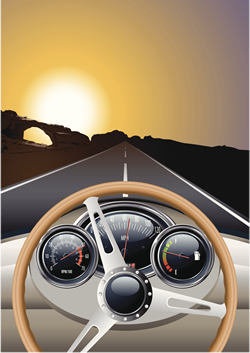
by Rich Flynn, ACORD
While folks like Google have apparently never seen The Terminator, and insist on developing driverless cars which will surely rebel and become our wheeled overlords someday, the flesh-and-blood driver is not obsolete yet. But even a living, breathing person in the driver's seat has a quickly evolving arsenal of technology to keep them safer and get them to their destination on time... or at least, that's the idea.
So let's forget Arnold and The Terminator and take some inspiration from another film: The Good, the Bad and the Ugly. If Clint Eastwood's Man with No Name were behind the wheel of a 21st-century car, instead of sitting astride a saddle, what sort of tech might he be dealing with?
The Good
Jaguar Land Rover recently revealed its development of something it calls the "360 Virtual Urban Windscreen" - a research program which aims to minimize blind spots by rendering the car's pillars effectively transparent. Small cameras on the car's exterior would feed live video to screens embedded in the surface of each pillar, which would activate when the driver signals a turn or even just looks over their shoulder, giving them unobstructed 360-degree vision.
The transparent pillars will even be connected to a heads-up display, which could potentially do anything from highlighting rapidly moving fellow motorists or pedestrians with a halo, to displaying gas prices above the pump or the number of available parking spaces at the garage. The ultimate expression of this technology, according to Jaguar Land Rover, will be "Follow-Me Ghost Car Navigation" - an image of another car projected in the driver's path, which will lead them turn-by-turn to their destination.
The Bad
Of course, technology is a double-edged sword. Take the case of the Texas Auto Center, an Austin dealership which specializes in selling cars to customers who would normally be considered poor credit risks. In an attempt to make the repo process less painful, they installed GPS-enabled "black boxes" in cars before they were sold, enabling them to locate the vehicle if necessary, deactivate the ignition, and even remotely start the horn honking.
When a few customers called to say their cars were mysteriously refusing to start, it seemed there might be a small glitch in the system. When Austin police were flooded with complaints of horns going off in the middle of the night all over the city, perhaps suspicions were raised. But when Texas Auto Center found that they couldn't restore the cars' functionality because their records had been altered - including attributing ownership of the cars to Jennifer Lopez and the deceased Tupac Shakur - they realized there was no chance the situation was simply an accident.
It turned out that Oscar Ramos-Lopez, an employee who had been recently laid off, had remotely accessed their system and wreaked all that havoc. More than a hundred Austin residents found themselves stranded with a dead car; Ramos-Lopez, at the time, was only twenty years old.
The Ugly
After his friend was seriously injured in an accident with a drowsy driver, Sam Wu set out to solve the problem of fatigue behind the wheel. His solution is a device called the U-Wake - a headband which uses EEG technology to monitor your brain activity while driving, decides when you're in danger of falling asleep, and then sends an alert to an app running on your smartphone. If the phone's vibration doesn't startle you fully awake, the app can automatically text your family and friends - or even post a status update on your behalf - inviting them to give you a call to check on you.
Why does this qualify as "the ugly"? Well, the headband itself, for starters. CNET's review simply couldn't get over the fact of how goofy-looking the thing is, expressing doubt that motorists would willingly wear it in public, even if it meant risking falling asleep at the wheel. And unfortunately - whether fashion sense was the reason or not - U-Wave's Kickstarter campaign failed in a big way: the company only made it $2,273 of the way to their $200,000 goal.
However, Yahoo! Tech put things in perspective in their own U-Wave review. "There are plenty of companies... sanding the edges on smartphones and spewing out new messaging apps and minimally improving existing storage options," said Tech Editor Jason O. Gilbert. "This is a company that is using the computers in our pocket, and emerging brainwave-reading technology, in an attempt to solve an actual, high-risk problem in modern society."
On a good day, technology can indeed solve problems. On a bad day - just ask Oscar Ramos-Lopez - it can be the problem. But either way, as long as humans keep occupying the driver's seat (however long that turns out to be), emerging tech will keep changing the way we see the road in front of us.